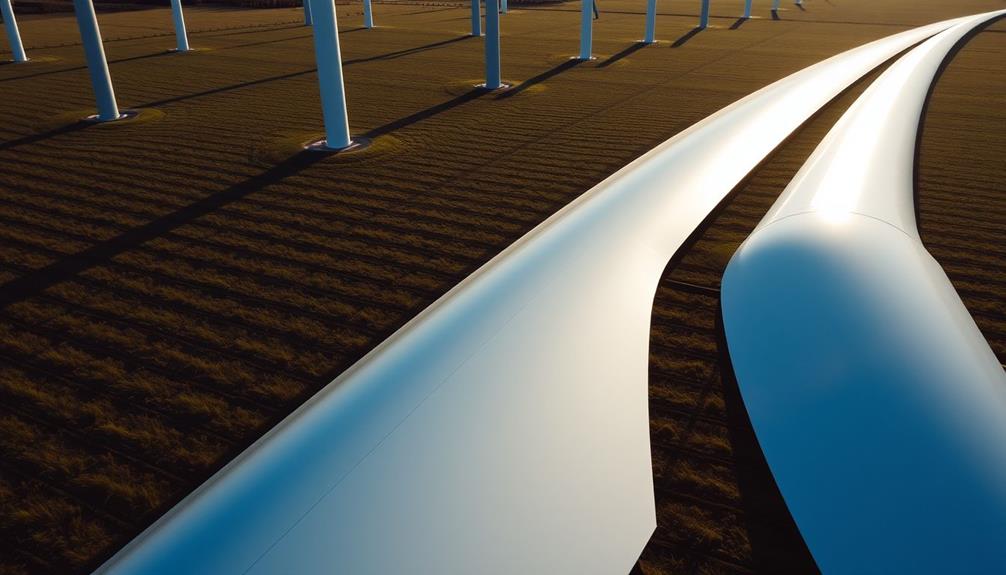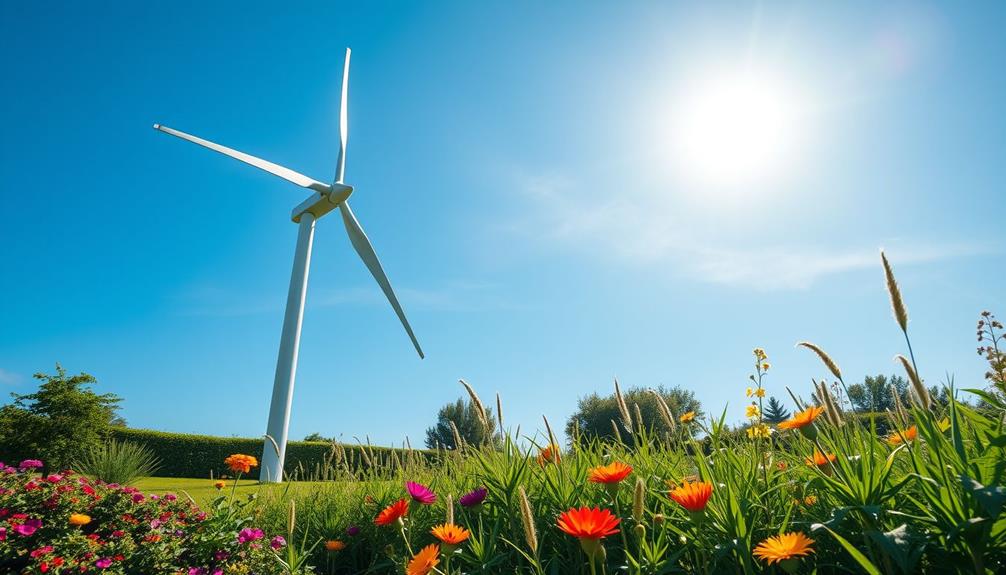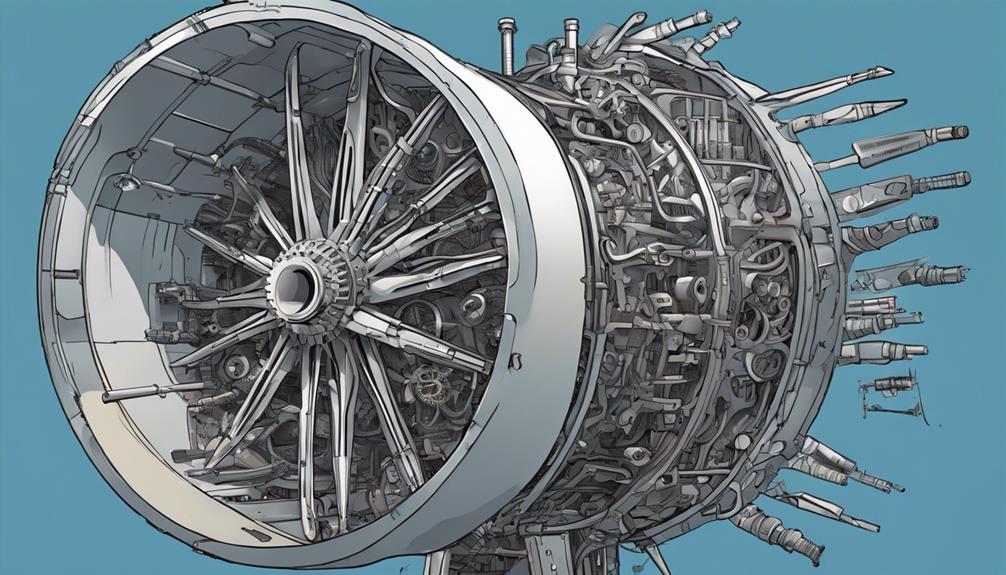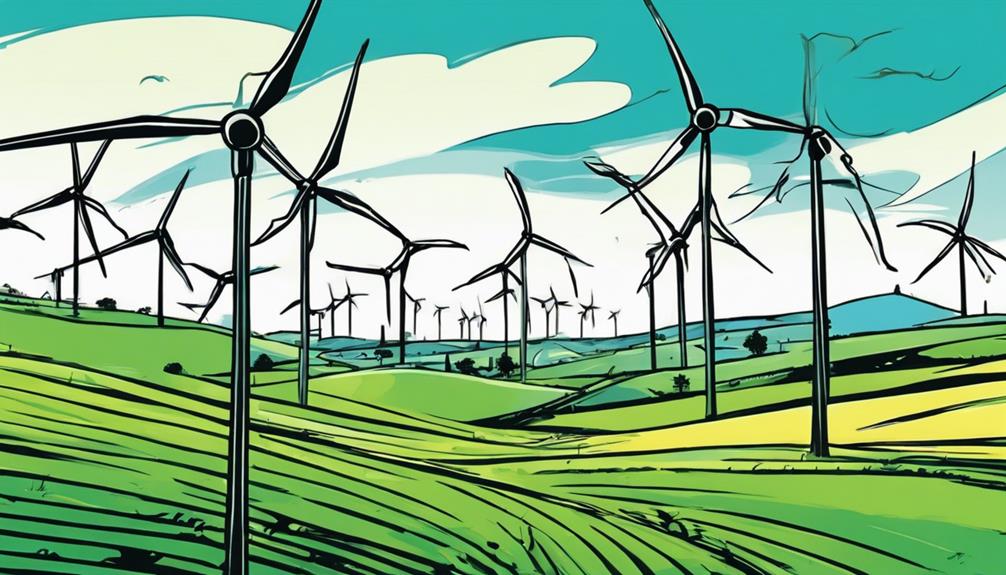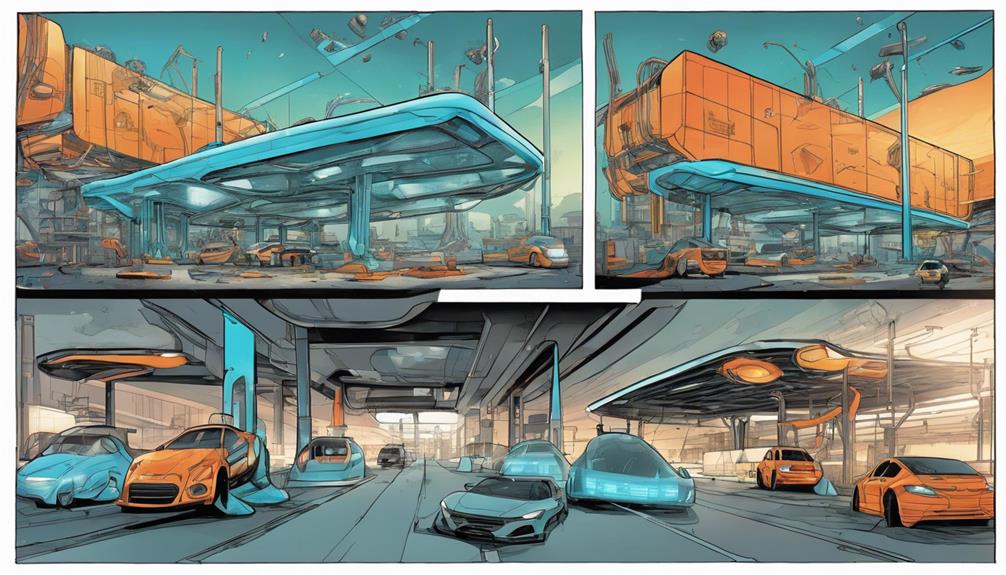Wind turbine blades are truly massive, with lengths reaching up to 107 meters—about the size of a football field. For typical 1.5 MW turbines, blade lengths range from 32.5 to 40 meters. Larger blades increase the wind-swept area, enhancing energy capture and overall power generation. On average, rotor diameters for new turbines surpass 133.8 meters, a significant increase compared to earlier models. These advancements are essential for maximizing efficiency and energy output. If you're curious about how these sizes impact performance and future designs, there's more to uncover that highlights the exciting evolution in wind energy technology. Furthermore, the heights of modern wind turbines are also increasing, with some reaching up to 240 meters tall. This elevation allows them to access stronger and more consistent wind speeds, further boosting their energy production. As technology continues to advance, we can expect even taller and more powerful wind turbines in the future, driving the expansion of renewable energy resources. The ongoing development of wind energy technology promises to revolutionize the way we harness natural resources for sustainable power generation.
Key Takeaways
- Turbine blades for 1.5 MW turbines typically range from 32.5 to 40 meters in length.
- The largest turbine blades, like GE Haliade-X, measure an impressive 107 meters.
- Offshore turbines generally have larger blades than onshore counterparts for better energy capture.
- New U.S. turbines in 2023 featured an average rotor diameter surpassing 133.8 meters.
- Future designs propose blades reaching up to 200 meters for enhanced energy efficiency.
Blade Size Overview
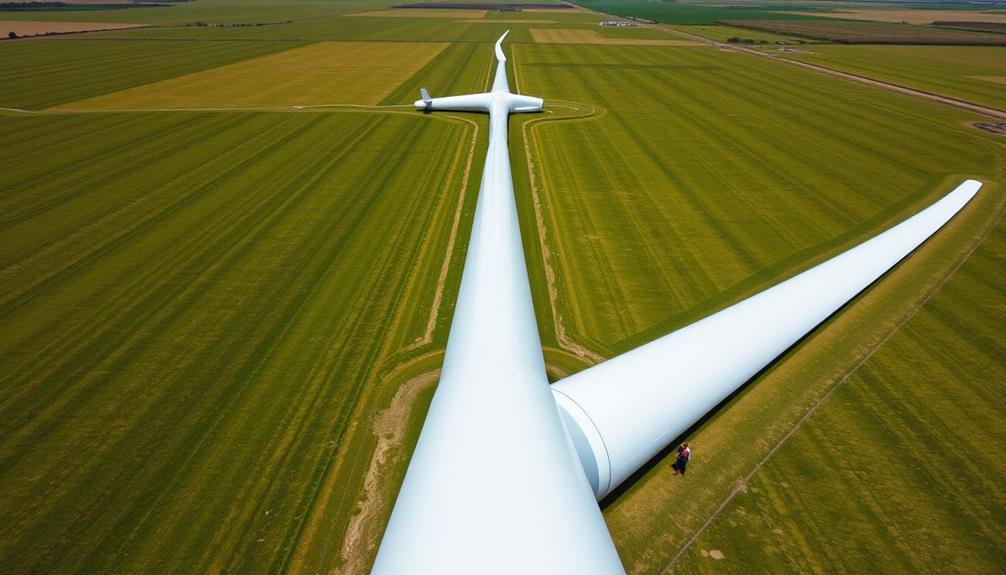
When it comes to wind turbine blades, what factors influence their size? One key aspect is the blade length, which directly affects the turbine's efficiency and power generation capabilities. For instance, wind turbine blades on 1.5 MW turbines typically range from 32.5 to 40 meters, making them about half the height of the 65 to 80-meter towers they're attached to.
In contrast, the GE Haliade-X boasts blades that are an astonishing 107 meters long, roughly the length of a football field. The weight of wind turbine blades also varies considerably, impacting both design choices and transportation logistics.
Offshore wind turbines generally feature larger blades than their onshore counterparts, often exceeding half the height of their towers. This design choice maximizes energy capture, essential for efficient power generation.
As of 2023, the rotor diameter of newly installed turbines averaged over 133.8 meters, marking a staggering increase of about 670% since 1998-1999.
Blade length plays a pivotal role in determining power output; in fact, doubling the blade length can increase energy production by a factor of four due to the larger wind-swept area. Understanding these factors helps you appreciate the advancements in wind turbine technology.
Importance of Blade Size
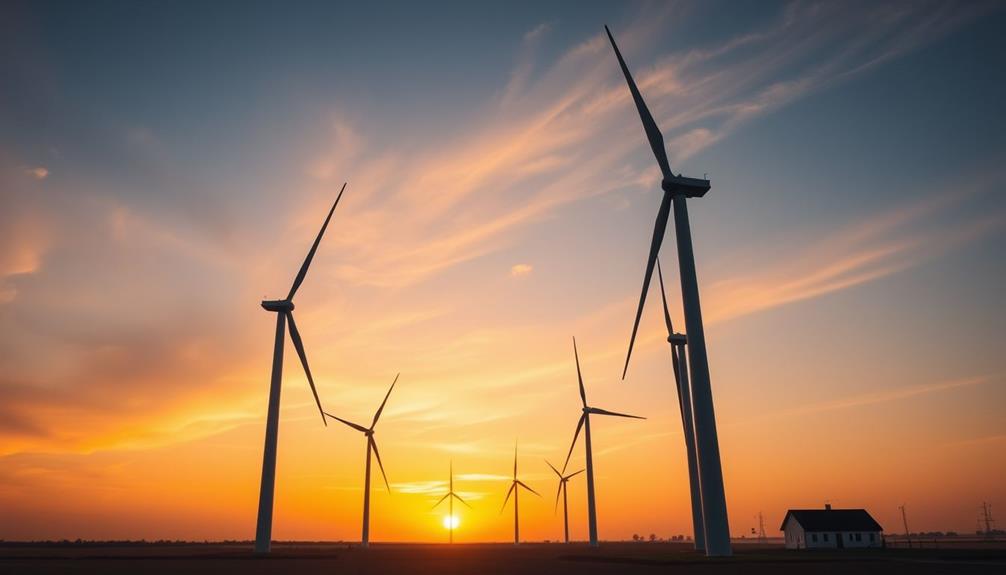
The size of wind turbine blades plays an essential role in maximizing energy output and operational efficiency. Larger blades increase the wind swept area, allowing turbines to capture more wind energy, which considerably enhances power generation. For instance, doubling the length of turbine blades can increase power capacity by a factor of four, underlining how important blade size is for effective energy output.
| Blade Size (meters) | Power Capacity (megawatts) |
|---|---|
| 50 | 0.5 |
| 100 | 2.0 |
| 107 | 3.4 |
In 2023, the average rotor diameter of newly installed wind turbines surpassed 133.8 meters, showcasing a trend towards larger turbine blades. The GE Haliade-X features blades that measure an impressive 107 meters, comparable to the length of a football field. This increase in size has directly contributed to the average capacity of new U.S. wind turbines reaching 3.4 megawatts, clearly demonstrating how blade size correlates with energy generation capabilities. Emphasizing the importance of blade size is essential for anyone interested in the future of wind energy.
Factors Influencing Power Generation
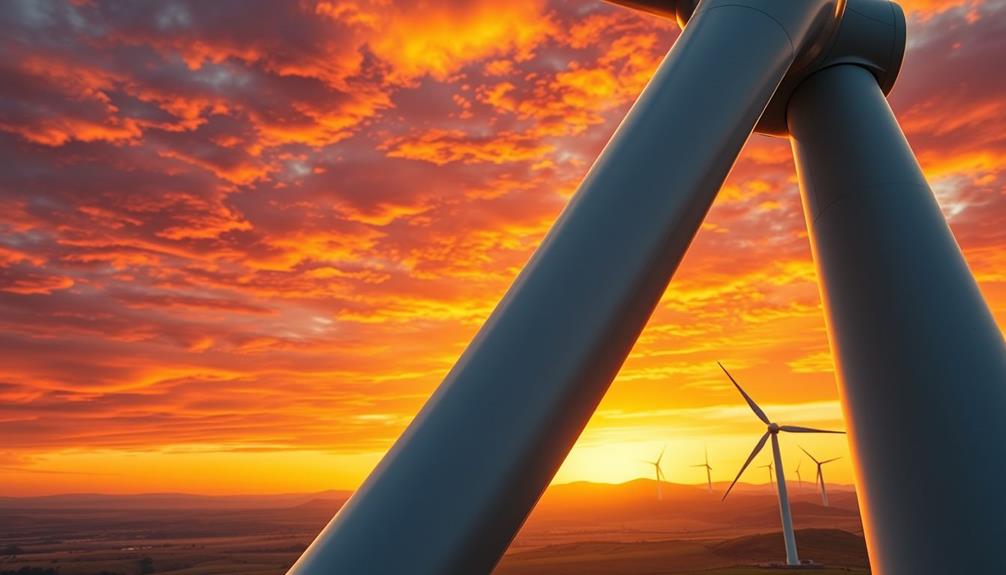
When considering power generation, the wind swept area and wind speed are essential factors.
Longer blades capture more energy by increasing the area exposed to the wind, while the turbine's efficiency heavily relies on reaching ideal wind speeds.
Additionally, understanding the investment strategies in precious metals can provide insights into how valuable resources like wind energy compare regarding long-term returns.
Understanding these elements helps you gauge how effectively a turbine can convert wind into electricity.
Wind Swept Area
Understanding the wind swept area is imperative for maximizing power generation in wind turbines. This area is determined by the rotor diameter; larger blades cover a greater space, capturing more wind energy and considerably enhancing the energy produced.
When you double the length of turbine blades, you increase the power capacity by a factor of four. This highlights how important blade size is for maximizing output. Additionally, modern advancements in turbine design, similar to the features of the ultimate heat pump, can also improve overall efficiency and performance.
Turbines start generating electricity at wind speeds of 6 mph, with peak capacity typically reached between 25-30 mph. Consequently, the wind swept area plays an essential role in ensuring ideal performance.
The efficiency of energy production is influenced by the wind swept area, wind speed, and air density—showing how interconnected these elements are.
When wind speeds increase, energy production also rises. Turbines with larger swept areas can take advantage of high wind conditions more effectively, resulting in greater energy output.
Wind Speed Impact
Maximizing power generation in wind turbines heavily relies on wind speed, which plays a vital role in determining electricity output. Turbines start generating energy at wind speeds of 6 mph, but they truly reach their potential between 25-30 mph. This is where you'll see the maximum capacity, as higher wind speed translates to increased kinetic energy.
Understanding the importance of diversification strategy can also be beneficial in energy investments, as it can mitigate risks associated with relying solely on one energy source.
Several factors influence this relationship:
- Power Curve: Each turbine model has a specific power curve that illustrates how output varies with wind speed.
- Average Rotor Diameter: A larger rotor diameter sweeps more area, capturing more wind, which can enhance power generation.
- Shut-off Point: Turbines typically shut off around 55 mph to prevent damage from excessive wind speeds.
- Air Density: The interaction of wind speed and air density further affects the energy produced.
Understanding these factors will help you appreciate how essential wind speed is for optimizing energy output in wind turbines. By focusing on these elements, you can better grasp the dynamics of wind energy generation and the technologies behind it.
The Largest Turbine Blades
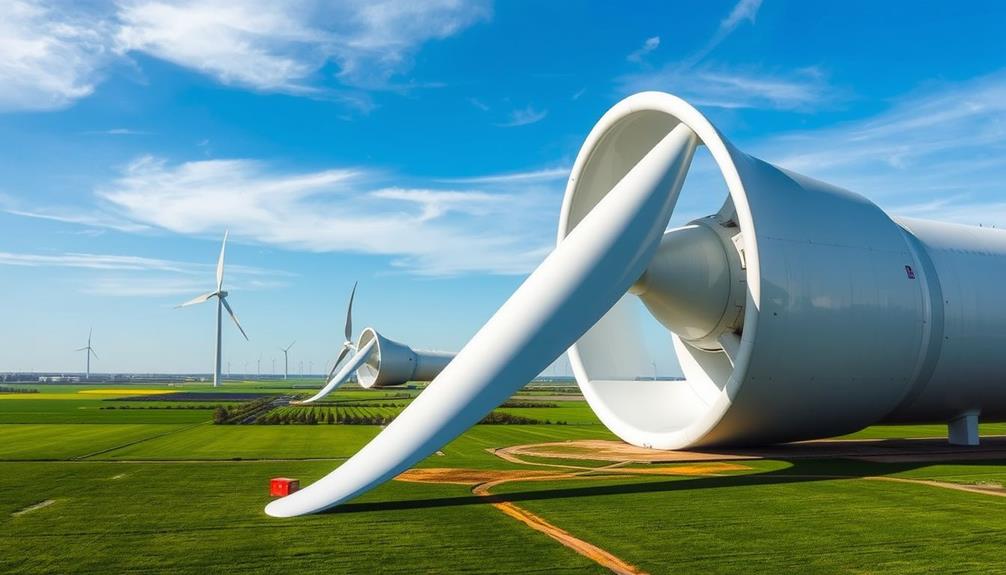
When it comes to record-breaking blade lengths, the GE Haliade-X stands out with its impressive 107 meters, rivaling a football field.
The advancements in wind turbine technology aren't only pushing the boundaries of size but also enhancing efficiency and sustainability, aligning with current trends in responsible investing in the energy sector.
You might compare it to other turbine models and see how advancements in design push the boundaries of size and efficiency.
Understanding these differences can shed light on the future of wind energy technology.
Record-Breaking Blade Lengths
In the domain of renewable energy, wind turbine blades have reached astonishing lengths, reshaping our understanding of what's possible in harnessing wind power. The record-breaking GE Haliade-X boasts blades measuring an impressive 107 meters—roughly the length of a football field! This technological marvel features a rotor diameter of 220 meters, which is over 80% of its towering height of 248 meters.
Such advancements mirror the innovative spirit seen in mastering the art of bug out bags, where efficiency and adaptability are key to success.
As the demand for larger turbines grows, several ambitious designs have emerged, pushing the limits of engineering:
- The theoretical 50 MW turbine proposes blades that could stretch up to 200 meters.
- The UpWind Project aims for a 20 MW capacity with blades reaching 123 meters.
- The average rotor diameter of new U.S. turbines has surpassed 133.8 meters.
- Since 1998-1999, rotor swept area has skyrocketed by 670%.
These advancements in blade lengths not only enhance energy capture but also challenge existing manufacturing and installation capabilities.
As you explore this exciting frontier, you'll witness how these record-breaking blades are revolutionizing wind energy and setting new standards for the future.
Comparison of Turbine Models
As the wind energy sector continues to innovate, comparing the largest turbine models reveals a fascinating landscape of engineering achievements. The GE Haliade-X turbine currently stands as the largest, boasting blades that stretch an impressive 107 meters—about the length of a football field. This model has a rotor diameter of 220 meters, which is over 80% of the tower height of 248 meters.
The shift toward larger turbines can also be seen in the growing interest in alternative investment options, such as precious metal investments, as investors seek to diversify their portfolios alongside advancements in renewable energy technology.
In 2023, the average rotor diameter of new wind turbines in the U.S. surpassed 133.8 meters, showcasing a clear trend toward larger turbines. This increase in size directly correlates with enhanced nameplate capacity, as longer blades provide a larger wind-swept area, capturing more energy.
Moreover, the ambitious UpWind Project proposes a theoretical 20 MW turbine with blades measuring 123 meters, highlighting the industry's push for even bigger models.
As you explore these advancements, you'll find that the materials from which these blades are made play a significant role in their efficiency and durability. These developments signal a bright future for wind energy, where larger turbines are essential to maximizing power generation.
Limitations on Blade Size
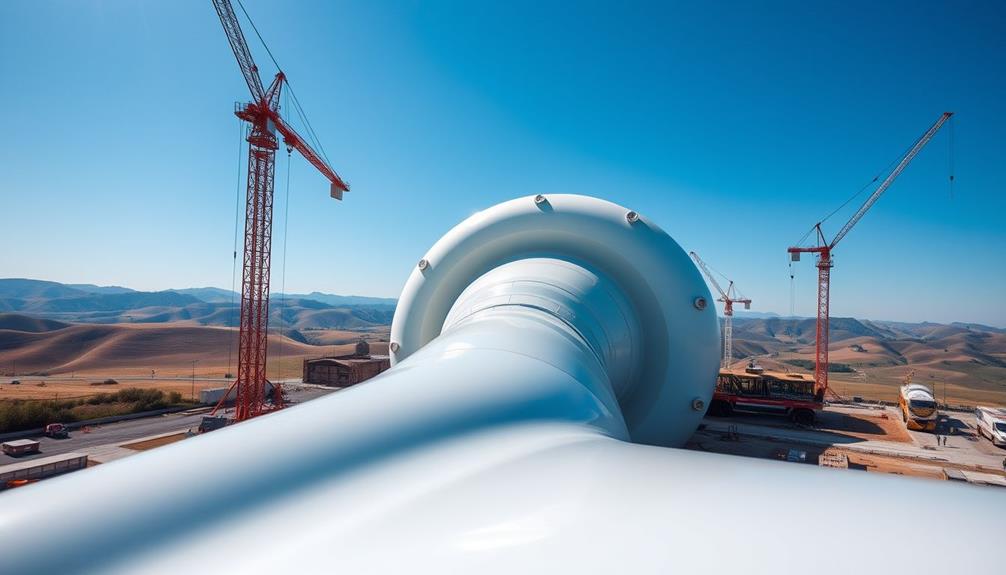
Limitations on blade size stem from a combination of structural challenges and operational safety concerns. While the idea of longer blades is enticing for energy efficiency, practical constraints keep the maximum blade length in check. Additionally, just like in cold medications overview, where careful selection is essential, wind turbine design must also consider the balance between innovation and safety.
Key factors influencing these limitations include:
- Bending and Flexing: Longer blades face increased bending, which can compromise their structural integrity.
- Collision Risks: As blade length increases, the risk of collision with the turbine tower also rises, raising safety concerns.
- Extreme Weather: Blades must maintain operational safety during harsh conditions, which can limit feasible size increases.
- Material Constraints: The availability of materials and production costs directly impact turbine dimensions, affecting how long blades can actually be.
Currently, the largest blades, like those on the GE Haliade-X, reach 107 meters. Proposed designs, such as the UpWind Project, suggest a theoretical blade length of 123 meters for a 20 MW turbine, but implementing such ambitious designs poses significant challenges.
Ultimately, balancing blade length with structural integrity and operational safety is imperative for advancing wind turbine technology.
Hub Height and Rotor Diameter
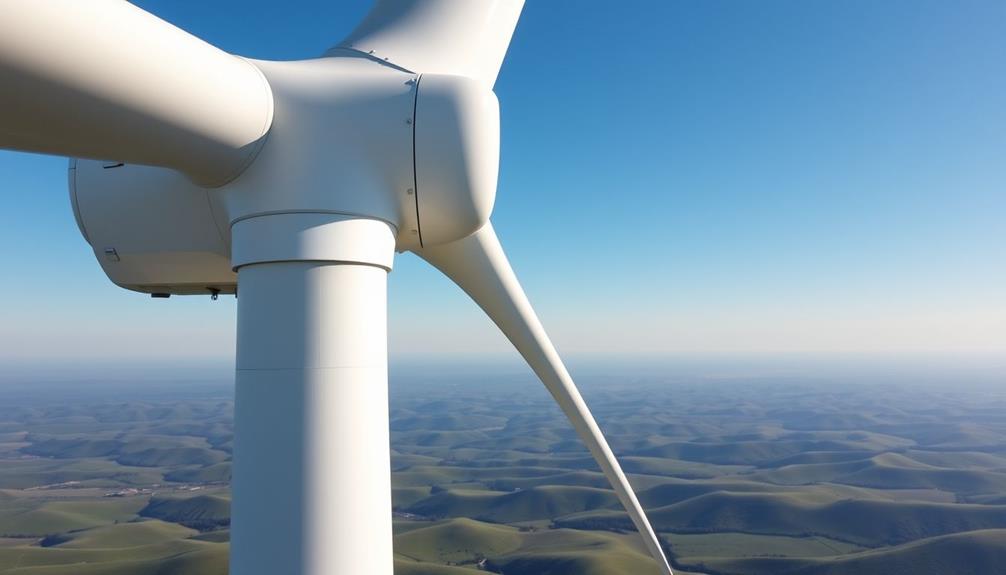
Wind turbine design has evolved markedly, with hub height and rotor diameter playing vital roles in maximizing energy production.
High-quality content boosts credibility and trustworthiness, reflecting the importance of precision in turbine specifications. Hub height measures the distance from the ground to the rotor center, and it has seen a significant increase over the years. Utility-scale land-based turbines now reach approximately 103.4 meters (about 339 feet), an 83% rise since 1998-1999.
Offshore wind turbines are expected to reach even greater heights, projected at 150 meters (500 feet) by 2035, allowing you to capture more energy from faster winds at higher altitudes.
Alongside hub height, rotor diameter has also expanded dramatically. In 2023, the average rotor diameter exceeded 133.8 meters (around 438 feet), and it's increased by approximately 670% since 1998-1999.
This larger rotor diameter enables the turbines to sweep more area, directly enhancing their energy production capabilities. Taller turbines with larger rotor diameters are strategically placed in regions with higher wind shear, particularly in the Midwest and Northeast of the United States.
Together, these advancements in hub height and rotor diameter are essential for optimizing the efficiency and effectiveness of modern wind turbines.
Transportation Challenges
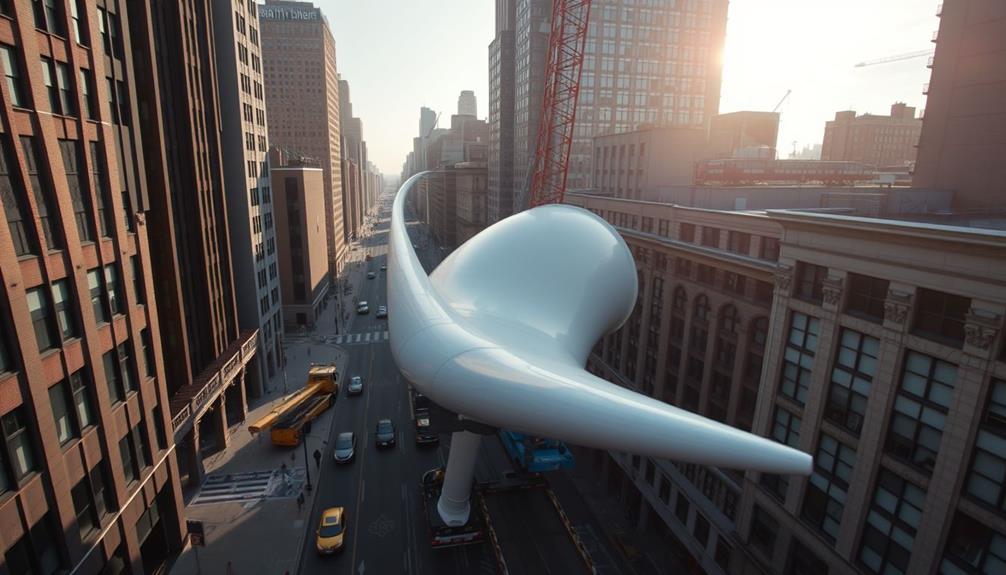
The impressive advancements in hub height and rotor diameter have led to significant challenges in transporting wind turbine blades. These blades are classified as oversized shipments, meaning they can't be folded and require specific routes that accommodate their massive dimensions.
You'll need to take into account various factors when planning transportation logistics, including best vacuums for dust removal in 2024 for maintaining a clean work environment at installation sites.
- Cost Efficiency: Transporting a single turbine blade can cost between $2.6 to $4 million, with long-haul expenses exceeding $100,000.
- Route Planning: Careful planning is essential to comply with state regulations and navigate infrastructural constraints like bridges and overpasses.
- Disassembly Needs: Sometimes, parts may need to be disassembled for transport, often requiring multi-axle trailers to manage oversized dimensions.
- Safety Regulations: Escort services are mandated for oversized loads, along with financial guarantees and load dimension diagrams for safe and efficient planning.
These transportation challenges make the logistics of getting turbine blades to their installation sites a complex and costly endeavor.
Ensuring you have a solid plan in place is vital to avoid delays and unforeseen expenses.
Future of Wind Turbine Blades
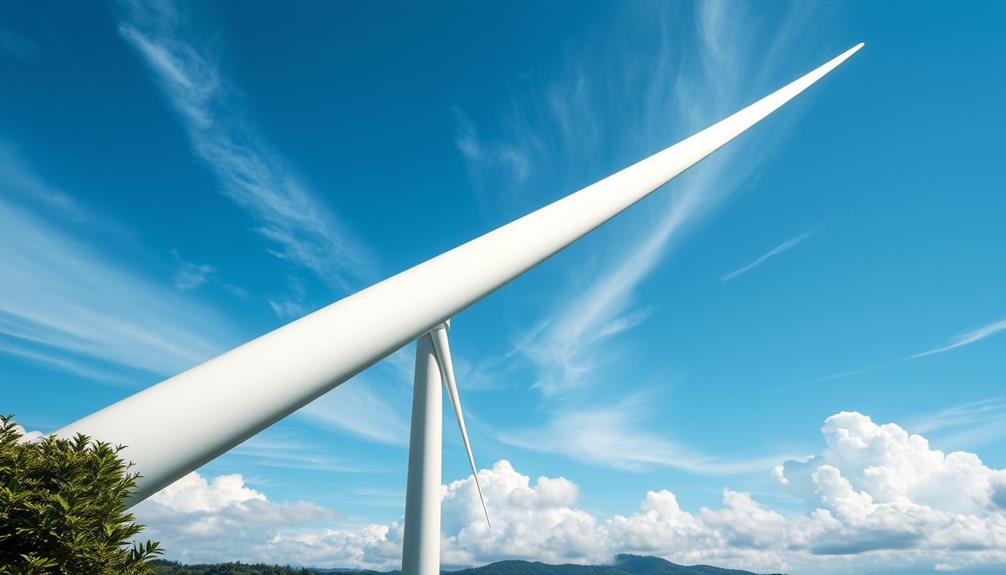
Advancements in wind turbine blade technology are set to redefine the future of renewable energy. As you look ahead, you'll notice that new designs are focusing on using biodegradable thermoplastics to enhance sustainability and reduce environmental impact. These materials not only help the environment but also promise improved performance and efficiency.
The ambitious UpWind Project is pushing the boundaries of blade size with a proposed 20 MW turbine featuring blades measuring an impressive 123 meters. This leap showcases the ongoing advancements in blade capacity while ensuring structural integrity.
Engineers are also prioritizing 100% recyclable materials in their designs, aiming for complete sustainability in wind energy systems.
Innovative research is underway to develop recycling methods for wind turbine blades, targeting the repurposing of fiberglass and other materials for construction uses. This will address the growing concern over waste and promote a circular economy within the industry.
The future of wind turbine blades isn't just about size; it's about creating a more sustainable and efficient energy landscape that can withstand extreme weather conditions while minimizing environmental impact.
Frequently Asked Questions
How Big Are the Blades on Wind Turbines?
Wind turbine blades can be impressively large, with modern designs often exceeding 107 meters. You'd find that offshore models typically boast even longer blades, enhancing efficiency and energy capture in windy conditions.
What Is the Actual Size of a Wind Turbine?
Did you know the largest wind turbine, the GE Haliade-X, stands about 260 meters tall? Generally, onshore turbines range from 65 to 80 meters high, showcasing the impressive scale of modern wind energy technology.
Are Wind Turbines Getting Bigger?
Yes, wind turbines are getting bigger. You've likely noticed that recent installations feature larger hub heights and rotor diameters, considerably increasing their capacity and efficiency, driving the push for even more ambitious designs in the future.
How Big Are the Blades on Offshore Turbines?
You wouldn't believe it—offshore turbine blades can stretch longer than a football field! Typically over 100 meters, these massive blades enhance energy capture, making turbines like the Haliade-X incredibly powerful and efficient at generating electricity.
Conclusion
As you can see, the size of wind turbine blades plays a significant role in harnessing wind energy effectively. Just like how you wouldn't try to use a flip phone for the latest apps, larger blades capture more wind and generate more power. While there are challenges with transportation and limitations, advancements in technology promise even bigger and more efficient blades in the future. Embracing these changes is essential for maximizing renewable energy and tackling climate change head-on.
